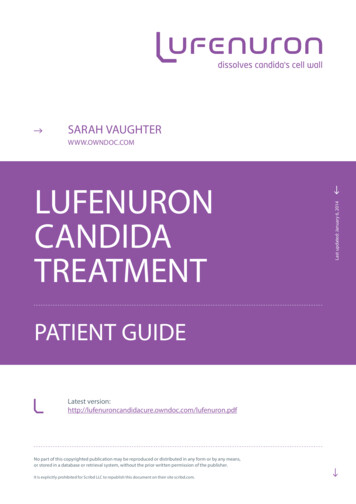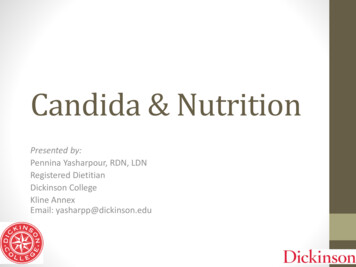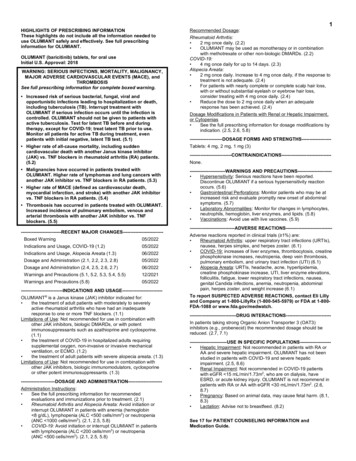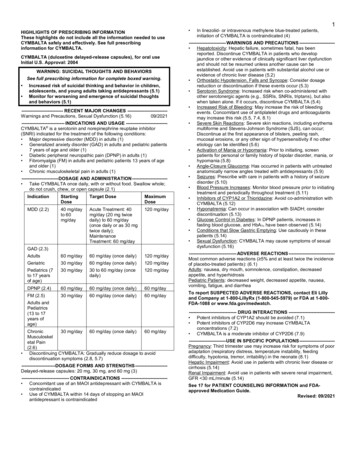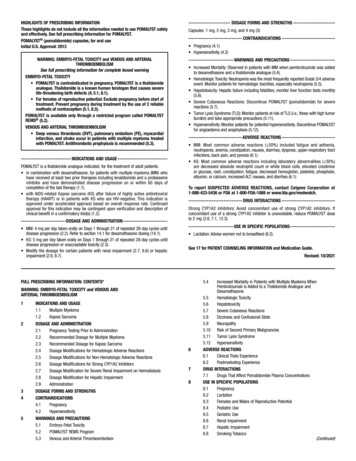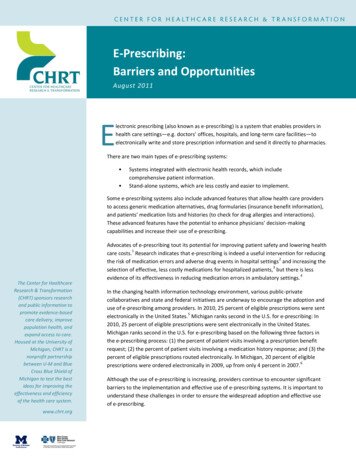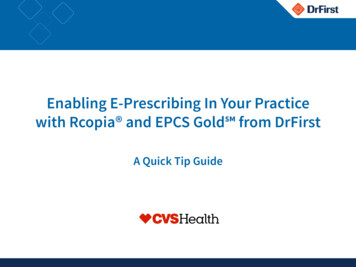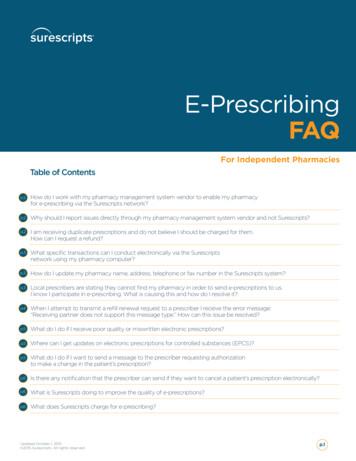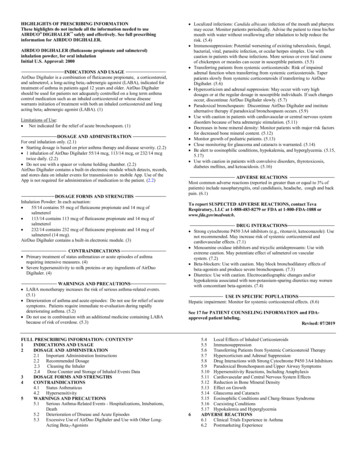
Transcription
HIGHLIGHTS OF PRESCRIBING INFORMATIONThese highlights do not include all the information needed to useAIRDUO DIGIHALER safely and effectively. See full prescribinginformation for AIRDUO DIGIHALER.AIRDUO DIGIHALER (fluticasone propionate and salmeterol)inhalation powder, for oral inhalationInitial U.S. Approval: 2000INDICATIONS AND USAGEAirDuo Digihaler is a combination of fluticasone propionate, a corticosteroid,and salmeterol, a long-acting beta2-adrenergic agonist (LABA), indicated fortreatment of asthma in patients aged 12 years and older. AirDuo Digihalershould be used for patients not adequately controlled on a long term asthmacontrol medication such as an inhaled corticosteroid or whose diseasewarrants initiation of treatment with both an inhaled corticosteroid and longacting beta2 adrenergic agonist (LABA). (1)Limitations of Use: Not indicated for the relief of acute bronchospasm. (1)DOSAGE AND ADMINISTRATIONFor oral inhalation only. (2.1) Starting dosage is based on prior asthma therapy and disease severity. (2.2) 1 inhalation of AirDuo Digihaler 55/14 mcg, 113/14 mcg, or 232/14 mcgtwice daily. (2.2) Do not use with a spacer or volume holding chamber. (2.2)AirDuo Digihaler contains a built-in electronic module which detects, records,and stores data on inhaler events for transmission to mobile App. Use of theApp is not required for administration of medication to the patient. (2.2)DOSAGE FORMS AND STRENGTHSInhalation Powder: In each actuation: 55/14 contains 55 mcg of fluticasone propionate and 14 mcg ofsalmeterol 113/14 contains 113 mcg of fluticasone propionate and 14 mcg ofsalmeterol 232/14 contains 232 mcg of fluticasone propionate and 14 mcg ofsalmeterol (14 mcg).AirDuo Digihaler contains a built-in electronic module. (3)CONTRAINDICATIONS Primary treatment of status asthmaticus or acute episodes of asthmarequiring intensive measures. (4) Severe hypersensitivity to milk proteins or any ingredients of AirDuoDigihaler. (4)WARNINGS AND PRECAUTIONS LABA monotherapy increases the risk of serious asthma-related events.(5.1) Deterioration of asthma and acute episodes: Do not use for relief of acutesymptoms. Patients require immediate re-evaluation during rapidlydeteriorating asthma. (5.2) Do not use in combination with an additional medicine containing LABAbecause of risk of overdose. (5.3)FULL PRESCRIBING INFORMATION: CONTENTS*1INDICATIONS AND USAGE2DOSAGE AND ADMINISTRATION2.1 Important Administration Instructions2.2 Recommended Dosage2.3Cleaning the Inhaler2.4Dose Counter and Storage of Inhaled Events Data3DOSAGE FORMS AND STRENGTHS4CONTRAINDICATIONS4.1 Status Asthmaticus4.2 Hypersensitivity5WARNINGS AND PRECAUTIONS5.1 Serious Asthma-Related Events - Hospitalizations, Intubations,Death5.2 Deterioration of Disease and Acute Episodes5.3 Excessive Use of AirDuo Digihaler and Use with Other LongActing Beta2-Agonists Localized infections: Candida albicans infection of the mouth and pharynxmay occur. Monitor patients periodically. Advise the patient to rinse his/hermouth with water without swallowing after inhalation to help reduce therisk. (5.4) Immunosuppression: Potential worsening of existing tuberculosis, fungal,bacterial, viral, parasitic infection, or ocular herpes simplex. Use withcaution in patients with these infections. More serious or even fatal courseof chickenpox or measles can occur in susceptible patients. (5.5) Transferring patients from systemic corticosteroids: Risk of impairedadrenal function when transferring from systemic corticosteroids. Taperpatients slowly from systemic corticosteroids if transferring to AirDuoDigihaler. (5.6) Hypercorticism and adrenal suppression: May occur with very highdosages or at the regular dosage in susceptible individuals. If such changesoccur, discontinue AirDuo Digihaler slowly. (5.7) Paradoxical bronchospasm: Discontinue AirDuo Digihaler and institutealternative therapy if paradoxical bronchospasm occurs. (5.9) Use with caution in patients with cardiovascular or central nervous systemdisorders because of beta adrenergic stimulation. (5.11) Decreases in bone mineral density: Monitor patients with major risk factorsfor decreased bone mineral content. (5.12) Monitor growth of pediatric patients. (5.13) Close monitoring for glaucoma and cataracts is warranted. (5.14) Be alert to eosinophilic conditions, hypokalemia, and hyperglycemia. (5.15,5.17) Use with caution in patients with convulsive disorders, thyrotoxicosis,diabetes mellitus, and ketoacidosis. (5.16)ADVERSE REACTIONSMost common adverse reactions (reported in greater than or equal to 3% ofpatients) include nasopharyngitis, oral candidiasis, headache, cough and backpain. (6.1)To report SUSPECTED ADVERSE REACTIONS, contact TevaRespiratory, LLC at 1-888-483-8279 or FDA at 1-800-FDA-1088 orwww.fda.gov/medwatch.DRUG INTERACTIONS Strong cytochrome P450 3A4 inhibitors (e.g., ritonavir, ketoconazole): Usenot recommended. May increase risk of systemic corticosteroid andcardiovascular effects. (7.1) Monoamine oxidase inhibitors and tricyclic antidepressants: Use withextreme caution. May potentiate effect of salmeterol on vascularsystem. (7.2) Beta-blockers: Use with caution. May block bronchodilatory effects ofbeta-agonists and produce severe bronchospasm. (7.3) Diuretics: Use with caution. Electrocardiographic changes and/orhypokalemia associated with non-potassium-sparing diuretics may worsenwith concomitant beta-agonists. (7.4)USE IN SPECIFIC POPULATIONSHepatic impairment: Monitor for systemic corticosteroid effects. (8.6)See 17 for PATIENT COUNSELING INFORMATION and FDAapproved patient labeling.Revised: 07/201965.4 Local Effects of Inhaled Corticosteroids5.5 Immunosuppression5.6 Transferring Patients from Systemic Corticosteroid Therapy5.7 Hypercorticism and Adrenal Suppression5.8 Drug Interactions with Strong Cytochrome P450 3A4 Inhibitors5.9 Paradoxical Bronchospasm and Upper Airway Symptoms5.10 Hypersensitivity Reactions, Including Anaphylaxis5.11 Cardiovascular and Central Nervous System Effects5.12 Reduction in Bone Mineral Density5.13 Effect on Growth5.14 Glaucoma and Cataracts5.15 Eosinophilic Conditions and Churg-Strauss Syndrome5.16 Coexisting Conditions5.17 Hypokalemia and HyperglycemiaADVERSE REACTIONS6.1 Clinical Trials Experience in Asthma6.2 Postmarketing Experience
78101112DRUG INTERACTIONS7.1 Inhibitors of Cytochrome P450 3A47.2 Monoamine Oxidase Inhibitors and Tricyclic Antidepressants7.3 Beta-Adrenergic Receptor Blocking Agents7.4 Non-Potassium-Sparing DiureticsUSE IN SPECIFIC POPULATIONS8.1 Pregnancy8.2 Lactation8.4 Pediatric Use8.5 Geriatric Use8.6 Hepatic Impairment8.7 Renal ImpairmentOVERDOSAGEDESCRIPTIONCLINICAL PHARMACOLOGY12.1 Mechanism of Action1314161712.2 Pharmacodynamics12.3 PharmacokineticsNONCLINICAL TOXICOLOGY13.1 Carcinogenesis, Mutagenesis, Impairment of Fertility13.2 Animal Toxicology and/or PharmacologyCLINICAL STUDIES14.1 Dose-Ranging Studies14.2 Trials in the Maintenance Treatment of AsthmaHOW SUPPLIED/STORAGE AND HANDLING16.1 How Supplied16.2 Storage and HandlingPATIENT COUNSELING INFORMATION*Sections or subsections omitted from the full prescribing information are notlisted.
FULL PRESCRIBING INFORMATION1INDICATIONS AND USAGE AirDuo Digihaler is indicated for the treatment of asthma in patients aged 12 years and older.AirDuo Digihaler should be used for patients not adequately controlled on a long term asthmacontrol medication such as an inhaled corticosteroid or whose disease warrants initiation oftreatment with both an inhaled corticosteroid and long acting beta2 adrenergic agonist (LABA).Limitations of Use:AirDuo Digihaler is NOT indicated for the relief of acute bronchospasm.2DOSAGE AND ADMINISTRATION2.1Important Administration InstructionsAdminister AirDuo Digihaler as 1 inhalation twice daily (approximately 12 hours apart at thesame time every day) by the orally inhaled route. Advise the patient to rinse his/her mouth withwater without swallowing after each inhalation. AirDuo Digihaler does not require priming. Do not use AirDuo Digihaler with a spacer or volume holding chamber. Do not use AirDuo Digihaler by other routes. Do not use more than two times every 24 hours. More frequent administration or agreater number of daily inhalations (more than one inhalation twice daily) is notrecommended as some patients are more likely to experience adverse reactions withhigher salmeterol dosages. Avoid the concomitant use of other long acting beta2 adrenergic agonist (LABAs) [seeWarnings and Precautions (5.3, 5.11)].If asthma symptoms arise in the period between doses, an inhaled, short-acting beta2-agonistshould be taken for immediate relief.2.2Recommended DosageThe recommended starting dosage for AirDuo Digihaler is based on asthma severity and currentinhaled corticosteroid use and strength. For example: For patients not taking inhaled corticosteroids (ICS) (with less severe asthma): select55/14 mcg (55 mcg of fluticasone propionate and 14 mcg of salmeterol), administeredtwice daily. For patients with greater asthma severity, use the higher dosages: either:o 113/14 mcg (113 mcg of fluticasone propionate and 14 mcg of salmeterol),administered twice daily; or
o 232/14 mcg (232 mcg of fluticasone propionate and 14 mcg of salmeterol),administered twice daily. For patients switching to AirDuo Digihaler from another inhaled corticosteroid orcombination product, select the low (55/14 mcg), medium (113/14 mcg) or high (232/14mcg) dose strength of AirDuo Digihaler based on the strength of the previous inhaledcorticosteroid product, or the strength of the inhaled corticosteroid from a combinationproduct, and disease severity.Improvement in asthma control following AirDuo Digihaler administration can occur within 15minutes of beginning treatment; although, maximum benefit may not be achieved for 1 week orlonger after starting treatment. Individual patients will experience a variable time to onset anddegree of symptom relief. For patients who do not respond adequately to the starting dosage after2 weeks of therapy, consider increasing the strength (replace with a higher strength) to possiblyprovide additional improvement in asthma control. The maximum recommended dosage ofAirDuo Digihaler is 232/14 mcg twice daily.If a previously effective dosage regimen fails to provide adequate improvement in asthmacontrol, the therapeutic regimen should be reevaluated and additional therapeutic options (e.g.,replacing the current strength of AirDuo Digihaler with a higher strength, adding additionalcontroller therapies) should be considered. After asthma stability has been achieved, it isdesirable to titrate to the lowest effective dosage to reduce the risk of adverse reactions.2.3Storing and Cleaning the Inhaler Keep the inhaler in a cool dry place. Routine maintenance is not required. If the mouthpiece needs cleaning, gently wipe themouthpiece with a dry cloth or tissue as needed. Never wash or put any part of the inhaler in water.2.4Dose Counter and Storage of Inhaler Events DataThe AirDuo Digihaler inhaler has a dose counter: The number 60 is displayed (prior to use). The dose counter will count down each time the mouthpiece is opened and closed [seePatient Counseling Information (17).AirDuo Digihaler contains a built-in electronic module which detects, records, and stores data oninhaler events, including peak inspiratory flow rate (L/minute), for transmission to the mobileApp where inhaler events are categorized. Use of the App is not required for administration offluticasone propionate and salmeterol to the patient. There is no evidence the use of the Appleads to improved clinical outcomes, including safety and effectiveness [see HowSupplied/Storage and Handling (16)].3DOSAGE FORMS AND STRENGTHSInhalation Powder: AirDuo Digihaler is an inhalation-driven, multidose dry powder inhaler(MDPI) with an electronic module, for oral inhalation that meters 55 mcg, 113 mcg, or 232 mcg
of fluticasone propionate with 14 mcg of salmeterol from the device reservoir and delivers 49mcg, 100 mcg, or 202 mcg of fluticasone propionate with 12.75 mcg of salmeterol, respectively,from the mouthpiece per actuation. The AirDuo Digihaler is a white inhaler with a yellow cap,and is provided in a sealed foil pouch with desiccant. AirDuo Digihaler contains a built-inelectronic module [see How Supplied/Storage and Handling (16.2)].4CONTRAINDICATIONS4.1Status AsthmaticusAirDuo Digihaler is contraindicated in the primary treatment of status asthmaticus or other acuteepisodes of asthma where intensive measures are required [see Warnings and Precautions (5.2)].4.2HypersensitivityAirDuo Digihaler is contraindicated in patients with known severe hypersensitivity to milkproteins or who have demonstrated hypersensitivity to fluticasone propionate or any of theexcipients [see Warnings and Precautions (5.10) and Description (11)].5WARNINGS AND PRECAUTIONS5.1Serious Asthma-Related Events – Hospitalizations, Intubations,DeathUse of LABA as monotherapy [without inhaled corticosteroids (ICS)] for asthma is associatedwith an increased risk of asthma-related death [see Salmeterol Multicenter Asthma ResearchTrial (SMART)]. Available data from controlled clinical trials also suggest that use of LABA asmonotherapy increases the risk of asthma-related hospitalization in pediatric and adolescentpatients. These findings are considered a class effect of LABA monotherapy. When LABA areused in fixed-dose combination with ICS, data from large clinical trials do not show a significantincrease in the risk of serious asthma-related events (hospitalizations, intubations, death)compared with ICS alone [see Serious Asthma-Related Events with Inhaled Corticosteroid/Longacting Beta2-adrenergic Agonists].Serious Asthma-Related Events with Inhaled Corticosteroid/Long-acting Beta2-adrenergicAgonistsFour large, 26-week, randomized, blinded, active-controlled clinical safety trials were conductedto evaluate the risk of serious asthma-related events when LABA were used in fixed-dosecombination with ICS compared with ICS alone in subjects with asthma. Three (3) trialsincluded adult and adolescent subjects aged 12 years and older: 1 trial comparedbudesonide/formoterol to budesonide, 1 trial compared fluticasone propionate/salmeterolinhalation powder to fluticasone propionate inhalation powder, and 1 trial compared mometasonefuroate/formoterol to mometasone furoate. The fourth trial included pediatric subjects aged 4 to
11 years and compared fluticasone propionate/salmeterol inhalation powder to fluticasonepropionate inhalation powder. The primary safety endpoint for all 4 trials was serious asthmarelated events (hospitalizations, intubations, death). A blinded adjudication committeedetermined whether events were asthma-related.The 3 adult and adolescent trials were designed to rule out a risk margin of 2.0, and the pediatrictrial was designed to rule out a risk margin of 2.7. Each individual trial met its pre-specifiedobjective and demonstrated non-inferiority of ICS/LABA to ICS alone. A meta-analysis of the 3adult and adolescent trials did not show a significant increase in risk of a serious asthma-relatedevent with ICS/LABA fixed-dose combination compared with ICS alone (Table 1). These trialswere not designed to rule out all risk for serious asthma-related events with ICS/LABAcompared with ICS.Table 1. Meta-analysis of Serious Asthma-Related Events in Subjects with Asthma Aged 12Years and OlderICS/LABA vs.ICSICS/LABA(n 17,537)Serious asthma-related event caICS(n 17,552)116105Asthma-related death20Asthma-related intubation(endotracheal)12115105Asthma-related hospitalization( 24-hour stay)aHazard Ratio(95% CI)b1.10 (0.85, 1.44)ICS Inhaled Corticosteroid; LABA Long-acting Beta2-adrenergic Agonist.abcRandomized subjects who had taken at least 1 dose of study drug. Planned treatment used foranalysis.Estimated using a Cox proportional hazards model for time to first event with baseline hazardsstratified by each of the 3 trials.Number of subjects with events that occurred within 6 months after the first use of study drug or 7days after the last date of study drug, whichever date was later. Subjects can have one or more events,but only the first event was counted for analysis. A single, blinded, independent adjudicationcommittee determined whether events were asthma related.The pediatric safety trial included 6,208 pediatric patients aged 4 to 11 years who receivedICS/LABA (fluticasone propionate/salmeterol inhalation powder) or ICS (fluticasone propionateinhalation powder). In this trial 27/3,107 (0.9%) of patients treated with ICS/LABA and 21/3,101
(0.7%) of patients treated with ICS experienced a serious asthma-related event. There were noasthma-related deaths or intubations. ICS/LABA did not show a significantly increased risk of aserious asthma-related event compared to ICS based on the prespecified risk margin (2.7), withan estimated hazard ratio of time to first event of 1.29 (95% CI: 0.73, 2.27).Salmeterol Multicenter Asthma Research Trial (SMART)A 28-week, placebo-controlled, U.S. trial that compared the safety of salmeterol with placebo,each added to usual asthma therapy, showed an increase in asthma-related deaths in subjectsreceiving salmeterol (13/13,176 in subjects treated with salmeterol versus 3/13,179 in subjectstreated with placebo; relative risk: 4.37 [95% CI: 1.25, 15.34]). Use of background ICS was notrequired in SMART. The increased risk of asthma-related death is considered a class effect ofLABA monotherapy.5.2Deterioration of Disease and Acute EpisodesAirDuo Digihaler should not be initiated in patients during rapidly deteriorating or potentiallylife-threatening episodes of asthma. AirDuo Digihaler has not been studied in subjects withacutely deteriorating asthma. The initiation of AirDuo Digihaler in this setting is not appropriate.Serious acute respiratory events, including fatalities, have been reported when salmeterol, acomponent of AirDuo Digihaler, has been initiated in patients with significantly worsening oracutely deteriorating asthma. In most cases, these have occurred in patients with severe asthma(e.g., patients with a history of corticosteroid dependence, low pulmonary function, intubation,mechanical ventilation, frequent hospitalizations, previous life-threatening acute asthmaexacerbations) and in some patients with acutely deteriorating asthma (e.g., patients withsignificantly increasing symptoms; increasing need for inhaled, short-acting beta2-agonists;decreasing response to usual medications; increasing need for systemic corticosteroids; recentemergency room visits; deteriorating lung function). However, these events have occurred in afew patients with less severe asthma as well. It was not possible from these reports to determinewhether salmeterol contributed to these events.Increasing use of inhaled, short-acting beta2-agonists is a marker of deteriorating asthma. In thissituation, the patient requires immediate reevaluation with reassessment of the treatmentregimen, giving special consideration to the possible need for replacing the current strength ofAirDuo Digihaler with a higher strength, adding additional inhaled corticosteroid, or initiatingsystemic corticosteroids. Patients should not use more than 1 inhalation twice daily of AirDuoDigihaler.AirDuo Digihaler should not be used for the relief of acute symptoms, i.e., as rescue therapy forthe treatment of acute episodes of bronchospasm. An inhaled, short-acting beta2-agonist, notAirDuo Digihaler, should be used to relieve acute symptoms such as shortness of breath. Whenprescribing AirDuo Digihaler, the healthcare provider should also prescribe an inhaled,short-acting beta2-agonist (e.g., albuterol) for treatment of acute symptoms, despite regulartwice-daily use of AirDuo Digihaler.
When beginning treatment with AirDuo Digihaler, patients who have been taking oral or inhaled,short-acting beta2-agonists on a regular basis (e.g., 4 times a day) should be instructed todiscontinue the regular use of these drugs.5.3Excessive Use of AirDuo Digihaler and Use with Other Long-ActingBeta2-AgonistsAirDuo Digihaler should not be used more often than recommended, at higher doses thanrecommended, or in conjunction with other medicines containing LABA, as an overdose mayresult. Clinically significant cardiovascular effects and fatalities have been reported inassociation with excessive use of inhaled sympathomimetic drugs. Patients using AirDuoDigihaler should not use another medicine containing a LABA (e.g., salmeterol, formoterolfumarate, arformoterol tartrate, indacaterol) for any reason.5.4Local Effects of Inhaled CorticosteroidsIn clinical trials, the development of localized infections of the mouth and pharynx with Candidaalbicans has occurred in subjects treated with fluticasone propionate and salmeterol MDPI.When such an infection develops, it should be treated with appropriate local or systemic (i.e.,oral) antifungal therapy while treatment with AirDuo Digihaler continues, but at times therapywith AirDuo Digihaler may need to be interrupted. Advise the patient to rinse his/her mouth withwater without swallowing following inhalation to help reduce the risk of ns who are using drugs that suppress the immune system are more susceptible to infectionsthan healthy individuals. Chickenpox and measles, for example, can have a more serious or evenfatal course in susceptible adolescents or adults using corticosteroids. In such patients who havenot had these diseases or who have not been properly immunized, particular care should be takento avoid exposure. How the dose, route and duration of corticosteroid administration affect therisk of developing a disseminated infection is not known. The contribution of the underlyingdisease and/or prior corticosteroid treatment to the risk is also not known. If a patient is exposedto chickenpox, prophylaxis with varicella-zoster immune globulin (VZIG) or pooled intravenousimmunoglobulin (IVIG) may be indicated. If a patient is exposed to measles, prophylaxis withpooled intramuscular immunoglobulin (IG) may be indicated. (See the respective package insertsfor complete VZIG and IG prescribing information.) If chickenpox develops, treatment withantiviral agents may be considered.Inhaled corticosteroids should be used with caution, if at all, in patients with active or quiescenttuberculosis infections of the respiratory tract; systemic fungal, bacterial, viral, or parasiticinfections; or ocular herpes simplex.5.6Transferring Patients from Systemic Corticosteroid TherapyParticular care is needed for patients who are transferred from systemically active corticosteroidsto inhaled corticosteroids because deaths due to adrenal insufficiency have occurred in patientswith asthma during and after transfer from systemic corticosteroids to less systemically available
inhaled corticosteroids. After withdrawal from systemic corticosteroids, a number of months arerequired for recovery of hypothalamic-pituitary-adrenal (HPA) function.Patients who have been previously maintained on 20 mg or more of prednisone (or itsequivalent) may be most susceptible, particularly when their systemic corticosteroids have beenalmost completely withdrawn. During this period of HPA suppression, patients may exhibit signsand symptoms of adrenal insufficiency when exposed to trauma, surgery, or infection(particularly gastroenteritis) or other conditions associated with severe electrolyte loss. AlthoughAirDuo Digihaler may improve control of asthma symptoms during these episodes, inrecommended doses it supplies less than normal physiological amounts of corticosteroidsystemically and does NOT provide the mineralocorticoid activity that is necessary for copingwith these emergencies.During periods of stress or a severe asthmatic attack, patients who have been withdrawn fromsystemic corticosteroids should be instructed to resume oral corticosteroids (in large doses)immediately and to contact their physician for further instruction. These patients should also beinstructed to carry a medical identification warning card indicating that they may needsupplementary systemic corticosteroids during periods of stress or a severe asthma attack.Patients requiring systemic corticosteroids should be weaned slowly from systemic corticosteroiduse after transferring to AirDuo Digihaler. Lung function (mean forced expiratory volume in1 second [FEV1] or morning peak expiratory flow [AM PEF]), beta-agonist use, and asthmasymptoms should be carefully monitored during withdrawal of systemic corticosteroids. Inaddition to monitoring asthma signs and symptoms, patients should be observed for signs andsymptoms of adrenal insufficiency, such as fatigue, lassitude, weakness, nausea and vomiting,and hypotension.Transfer of patients from systemic corticosteroid therapy to AirDuo Digihaler may unmaskallergic conditions previously suppressed by the systemic corticosteroid therapy (e.g., rhinitis,conjunctivitis, eczema, arthritis, eosinophilic conditions).During withdrawal from oral corticosteroids, some patients may experience symptoms ofsystemically active corticosteroid withdrawal (e.g., joint and/or muscular pain, lassitude,depression) despite maintenance or even improvement of respiratory function.5.7Hypercorticism and Adrenal SuppressionFluticasone propionate, a component of AirDuo Digihaler, will often help control asthmasymptoms with less suppression of HPA function than therapeutically equivalent oral doses ofprednisone. Since fluticasone propionate is absorbed into the circulation and can be systemicallyactive at higher doses, the beneficial effects of AirDuo Digihaler in minimizing HPA dysfunctionmay be expected only when recommended dosages are not exceeded and individual patients aretitrated to the lowest effective dose. A relationship between plasma levels of fluticasonepropionate and inhibitory effects on stimulated cortisol production has been shown after 4 weeksof treatment with fluticasone propionate inhalation aerosol. Since individual sensitivity to effectson cortisol production exists, physicians should consider this information when prescribingAirDuo Digihaler.Because of the possibility of significant systemic absorption of inhaled corticosteroids, patientstreated with AirDuo Digihaler should be observed carefully for any evidence of systemic
corticosteroid effects. Particular care should be taken in observing patients postoperatively orduring periods of stress for evidence of inadequate adrenal response.It is possible that systemic corticosteroid effects such as hypercorticism and adrenal suppression(including adrenal crisis) may appear in a small number of patients who are sensitive to theseeffects. If such effects occur, AirDuo Digihaler should be reduced slowly, consistent withaccepted procedures for reducing systemic corticosteroids, and for management of asthmasymptoms.5.8Drug Interactions with Strong Cytochrome P450 3A4 InhibitorsThe use of strong cytochrome P450 3A4 (CYP3A4) inhibitors (e.g., ritonavir, atazanavir,clarithromycin, indinavir, itraconazole, nefazodone, nelfinavir, saquinavir, ketoconazole,telithromycin) with AirDuo Digihaler is not recommended because increased systemiccorticosteroid and increased cardiovascular adverse effects may occur [see DrugInteractions (7.1) and, Clinical Pharmacology (12.3)].5.9Paradoxical Bronchospasm and Upper Airway SymptomsAs with other inhaled medicines, AirDuo Digihaler can produce paradoxical bronchospasm,which may be life-threatening. If paradoxical bronchospasm occurs following dosing withinhaled fluticasone propionate/salmeterol medicines, it should be treated immediately with aninhaled, short-acting bronchodilator; inhaled fluticasone propionate/salmeterol medicines shouldbe discontinued immediately; and alternative therapy should be instituted. Upper airwaysymptoms of laryngeal spasm, irritation, or swelling, such as stridor and choking, have beenreported in patients receiving inhaled fluticasone propionate/salmeterol medicines.5.10Hypersensitivity Reactions, Including AnaphylaxisImmediate hypersensitivity reactions (e.g., urticaria, angioedema, rash, bronchospasm,hypotension), including anaphylaxis, may occur after administration of AirDuo Digihaler. Therehave been reports of anaphylactic reactions in patients with severe milk protein allergy afterinhalation of other powder products containing lactose; therefore, patients with severe milkprotein allergy should not use AirDuo Digihaler [see Contraindications (4)].5.11Cardiovascular and Central Nervous System EffectsExcessive beta-adrenergic stimulation has been associated with seizures, angina, hypertension orhypotension, tachycardia with rates up to 200 beats/min, arrhythmias, nervousness, headache,tremor, palpitation, nausea, dizziness, fatigue, malaise, and insomnia [see Overdosage (10.2)].Therefore, AirDuo Digihaler, like all products containing sympathomimetic amines, should beused with caution in patients with cardiovascular disorders, especially coronary insufficiency,cardiac arrhythmias, and hypertension.Salmeterol, a component of AirDuo Digihaler, can produce a clinically significant cardiovasculareffect in some patients as measured by pulse rate, blood pressure, and/or symptoms. Althoughsuch effects are uncommon after administration of salmeterol at recommended doses, if theyoccur, the drug may need to be discontinued. In addition, beta-agonists have been reported toproduce electrocardiogram (ECG) changes, such as flattening of the T wave, prolongation of the
QTc interval, and ST segment depression. The clinical significance of these findings is unknown.Large doses of inhaled or oral salmeterol (12 to 20 times the recommended dose) have beenassociated with clinically significant prolongation of the QTc interval, which has the potential forproducing ventricular
2.1 Important Administration Instructions 2.2 Recommended Dosage 2.3 Cleaning the Inhaler 2.4 Dose Counter and Storage of Inhaled Events Data 3 DOSAGE FORMS AND STRENGTHS 4 CONTRAINDICATIONS 4.1 Status Asthmaticus 4.2 Hypersensitivity 5 WARNINGS AND PRECAUTIONS 5.1 Serious Asthma-Related Events - Hospitalizations, Intubations, .

